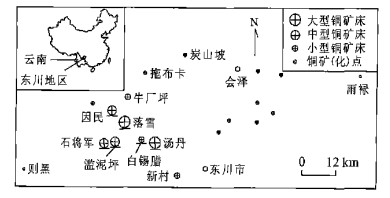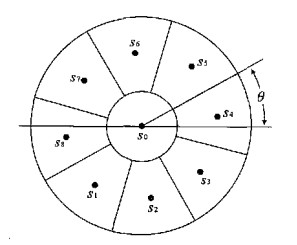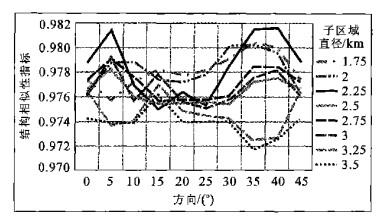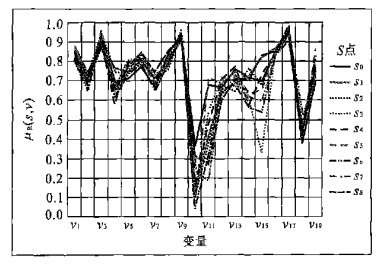Modeling the Spatial Patterns of Mineralization Environments Using Fuzzy Sets
-
摘要: 为了提高矿产预测的精度和可靠性, 必须分析和利用与矿床有关的空间结构信息.提出了一种用模糊集建立成矿环境空间结构模型的方法.成矿环境空间结构是地质变量在矿床周围的分布, 可用变量与空间点之间的模糊关系来描述.同一地区的同类矿床, 其空间结构具有一定相似性, 通过这种相似性的极大化可对结构模型进行优化.优化的结构模型是一种包含了方向和距离关系的特殊的空间关联规则集, 也是模糊推理矿产预测的推理规则库.通过模糊推理进行结构相似性的比较, 可对任意点上的找矿有利性进行预测.以云南东川地区铜矿预测的实例说明了该方法具有良好的应用效果.Abstract: The utilization of spatial structural information is essential for mineral prediction. This paper proposes a method for the fuzzy modeling of spatial patterns of mineralization environments (SPME). SPME is the spatial distribution of geological factors and geophysical, geochemical responses (geo-variables) on/around a deposit, described by fuzzy relations of the geo-variables to spatial points. SPME related to deposits of the same genetic type in a given region are to some extent structurally similar. Based on a set of known deposits in the region, a model of SPME of the region can be built, and by maximizing the structural similarity between those known deposits, the model can be optimized. The model serves as a fuzzy deduction rule base. To evaluate the prospecting potential of any point in the region, a pattern is built on the point and the structural similarity of the pattern to the model is calculated by fuzzy deduction. A case study of copper mineral deposit prediction in the Dongchuan region of Yunnan, China, shows that the method is highly effective.
-
Key words:
- fuzzy deduction /
- spatial data mining /
- mineral resources prediction /
- spatial pattern
-
图 5 东川铜矿找矿有利度等值线
图框位置及比例尺与图 1一致
Fig. 5. Contour map of prospecting favorability of copper mineral deposits of Dongchuan region
表 1 地质变量
Table 1. Geo-variables

-
Cox, D. P., Singer, D. A., 1986. Mineral deposit models. US Geological Survey Bulletin, 1693: 379. De Geoffroy, J. G., Wignall, T. K., 1985. Designing optimal strategies for mineral exploration. Plenum Press, New York, 1-363. Henley, R. W., Berger, B. R., 1993. What is an exploration model anyway—An analysis of the cognitive development and use of models in mineral exploration. In: Kirkham, R. V., Sinclair, W. D., Thorpe, R. I., et al., eds., Mineral deposits modeling. Special Paper 40, Geological Association of Canada, Ottava, 41-50. Koperski, K., Han, J., 1995. Discovery of spatial association rules in geographic information databases. In: Egenhofer, M. J., Herring, J. R., eds., Advances in spatial databases, LNCS 951. Springer-Verlag, Heidelberg, 47. Mu, X. Z., Xi, X. H., 1996. The advances in geochemical exploration of solid ore resources and the achievements gained. Geophysical & Geochemical Exploration, 20(4): 241-249(in Chinese with English abstract). http://en.cnki.com.cn/Article_en/CJFDTOTAL-WTYH604.000.htm Sun, K. X., Shen, Y. R., Liu, G. Q., et al., 1991. Proterozoic iron and copper deposits in Middle Yunnan. China University of Geosciences Press, Wuhan, 169(in Chinese). Tan, Y. B., Chen, G. F., 2000. A Gaussian clustering method based on maximum fuzzy entropy. Journal of UEST of China, 29(3): 269-272(in Chinese with English abstract). http://en.cnki.com.cn/Article_en/CJFDTOTAL-DKDX200003020.htm Yang, L. B., Gao, Y. Y., 2003. Fuzzy mathematics: Principle and applications. South China University of Technology Press, Guangzhou, 1-422(in Chinese). Zhang, Z. F., 2001. GIS-supported cell cluster methods of mineral resources prediction. Shaanxi Science and Technology Press, Xi'an, 1-140(in Chinese). Zhang, Z. F., Hu, G. D., Zeng, Z. R., 1999. Quantitative analogy between spatial geological structures in mineral resources prediction—Cell cluster concept and application. Earth Science—Journal of China University of Geosciences, 24(6): 661-664(in Chinese with English abstract). http://en.cnki.com.cn/Article_en/CJFDTOTAL-DQKX199906021.htm Zhao, P. D., Chen, J. P., Chen, J. G., 2001. Mineral diversity and mineralization spectrum. Earth Science—Journal of China University of Geosciences, 26(2): 111-117(in Chinese with English abstract). 牟绪赞, 奚小环. 1996, 固体矿产地球化学勘查进展与成果. 物探与化探, 20(4): 241-249. https://www.cnki.com.cn/Article/CJFDTOTAL-WTYH604.000.htm 孙克祥, 沈远仁, 刘国庆, 等, 1991. 滇中元古宙铁铜矿床. 武汉: 中国地质大学出版社, 1-169. 谭扬波, 陈光福, 2000. 一种基于最大模糊熵的高斯聚类算法. 电子科技大学学报, 29(3): 269-272. doi: 10.3969/j.issn.1001-0548.2000.03.012 杨纶标, 高英仪, 2003. 模糊数学原理及应用(第三版). 广州: 华南理工大学出版社, 1-422. 张振飞, 2001. GIS支持的矿产预测单元簇法. 西安: 陕西科学技术出版社, 1-140. 张振飞, 胡光道, 曾章仁, 1999. 矿产预测中空间地质结构的定量类比———单元簇的概念及其应用. 地球科学———中国地质大学学报, 24(6): 661-664. https://www.cnki.com.cn/Article/CJFDTOTAL-DQKX199906021.htm 赵鹏大, 陈建平, 陈建国, 2001. 成矿多样性与成矿谱系. 地球科学———中国地质大学学报, 26(2): 111-117. https://cdmd.cnki.com.cn/Article/CDMD-10491-1013354295.htm -










 下载:
下载:





